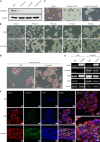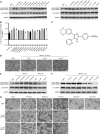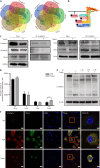Mechanism of trypsin-mediated differentiation of pancreatic progenitor cells into functional islet-like clusters
- PMID: 40548274
- PMCID: PMC12179872
- DOI: 10.4239/wjd.v16.i6.102727
Mechanism of trypsin-mediated differentiation of pancreatic progenitor cells into functional islet-like clusters
Abstract
Background: Endogenous regeneration of pancreatic islet β-cells is a path to cure both type 1 and advanced type 2 diabetes. Pancreatic cancer cell line-1 (PANC-1), a human pancreatic islet progenitor cell line, can be induced by trypsin to differentiate into insulin-secreting islet-like aggregates (ILAs). However, the underlying mechanism has not been explored.
Aim: To explore the mechanism and signaling pathway of trypsin-induced differentiation of islet progenitor cells into insulin-secreting cells.
Methods: PANC-1 cells were induced by trypsin to form ILAs and differentiate into insulin-secreting cells. Clustered regularly interspaced short palindromic repeats (CRISPR)-associated protein 9 knockout and small interfering RNA knockdown techniques were used to investigate membrane proteins and downstream signaling pathways involved in the process.
Results: The extracellular domain of membrane receptor E-cadherin hydrolyzed by trypsin induced the aggregation of PANC-1 cells and stimulated E-cadherin-recruited casein kinase-1γ3, which specifically phosphorylated the Ser655/Thr658 site of α-catenin in the cadherin-catenin complex, participating in the process of PANC-1 differentiation and affecting the maturation of differentiated ILAs.
Conclusion: The current study reveals the mechanism by which trypsin promotes PANC-1 cell differentiation into islet-like cells, providing a novel approach for endogenous islet β-cell regeneration.
Keywords: Alpha-catenin; E-cadherin; Endogenous islet β-cell regeneration; Pancreatic cancer cell line-1; Pancreatic islet progenitor cell; Trypsin.
©The Author(s) 2025. Published by Baishideng Publishing Group Inc. All rights reserved.
Conflict of interest statement
Conflict-of-interest statement: The authors have no conflicts of interest to declare.
Figures






Similar articles
-
Differentiation of Uc-MSCs into insulin secreting islet-like clusters by trypsin through TGF-beta signaling pathway.Differentiation. 2024 Jan-Feb;135:100744. doi: 10.1016/j.diff.2023.100744. Epub 2023 Dec 16. Differentiation. 2024. PMID: 38128465
-
RFX3 is essential for the generation of functional human pancreatic islets from stem cells.Diabetologia. 2025 Jul;68(7):1476-1491. doi: 10.1007/s00125-025-06424-4. Epub 2025 Apr 23. Diabetologia. 2025. PMID: 40263183 Free PMC article.
-
Increased inflammation as well as decreased endoplasmic reticulum stress and translation differentiate pancreatic islets from donors with pre-symptomatic stage 1 type 1 diabetes and non-diabetic donors.Diabetologia. 2025 Jul;68(7):1463-1475. doi: 10.1007/s00125-025-06417-3. Epub 2025 Jun 2. Diabetologia. 2025. PMID: 40457096 Free PMC article.
-
A rapid and systematic review of the clinical effectiveness and cost-effectiveness of paclitaxel, docetaxel, gemcitabine and vinorelbine in non-small-cell lung cancer.Health Technol Assess. 2001;5(32):1-195. doi: 10.3310/hta5320. Health Technol Assess. 2001. PMID: 12065068
-
Comparison of the effectiveness of inhaler devices in asthma and chronic obstructive airways disease: a systematic review of the literature.Health Technol Assess. 2001;5(26):1-149. doi: 10.3310/hta5260. Health Technol Assess. 2001. PMID: 11701099
References
-
- Sun H, Saeedi P, Karuranga S, Pinkepank M, Ogurtsova K, Duncan BB, Stein C, Basit A, Chan JCN, Mbanya JC, Pavkov ME, Ramachandaran A, Wild SH, James S, Herman WH, Zhang P, Bommer C, Kuo S, Boyko EJ, Magliano DJ. IDF Diabetes Atlas: Global, regional and country-level diabetes prevalence estimates for 2021 and projections for 2045. Diabetes Res Clin Pract. 2022;183:109119. - PMC - PubMed
-
- Zhang J, Liu F. The De-, Re-, and trans-differentiation of β-cells: Regulation and function. Semin Cell Dev Biol. 2020;103:68–75. - PubMed
-
- Zhang S, Huang F, Tian W, Lai J, Qian L, Hong W, Chen H, Li LC. Andrographolide promotes pancreatic duct cells differentiation into insulin-producing cells by targeting PDX-1. Biochem Pharmacol. 2020;174:113785. - PubMed
LinkOut - more resources
Full Text Sources

